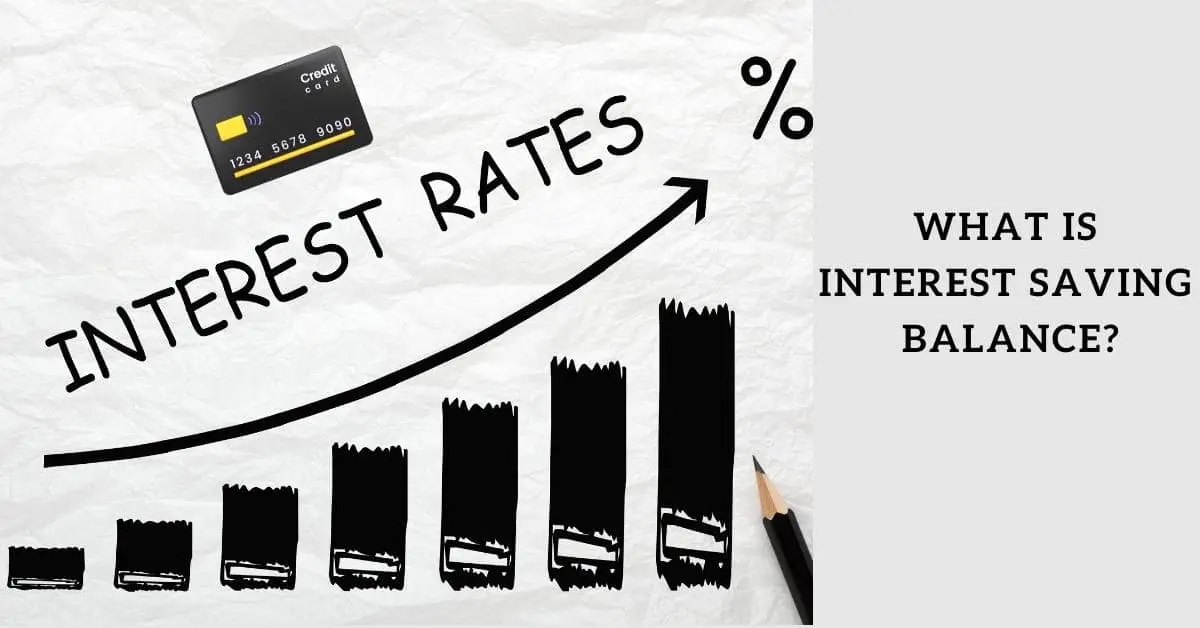Interest saving balance is the minimum amount your credit card issuer charges you so that you can avoid paying interest on the balance of your credit card. Moreover, if you pay your interest saving balance then you don’t have to pay interest on new purchases until the due date.
Credit cards are great personal finance tools. But if you are not careful with them, their high-interest rates can bury you in bad debt.
However, recently some credit card issuers introduced interest saving balance. Using this you can avoid paying high interest. But what is interest saving balance?
Well, you are about to find out. In this post, I am going to briefly explain what is an interest saving balance, how interest saving balance works, which banks offer it, whether is it right for you, and many more related queries. So, stick here.
Before we start talking about interest saving balance, let’s go over what credit cards are and how to use them.
What Are Credit Cards?
Credit cards are bank accounts that help you pay for expenses over a promotional period of time rather than all at once as you would have to with a debit card.
Credit cards are very helpful because they can make it easier to borrow money for the things you need; they can also assist you in getting qualified for larger expenses, such as a house or car. However, they can easily become a problem if you don’t use them correctly.
Let’s go over when you should and shouldn’t use credit cards, and then discuss how you can use them responsibly so that you never find yourself in debt that you can’t afford.
When Should You Use a Credit Card?
Credit cards are great for when you have unexpected expenses that you can’t cover with the money in your savings account or bank account.
Even if you do have the money on hand to pay for a given expense, you may choose to use a credit card anyway for a few different reasons. Here is why
- Firstly, credit cards have greater consumer protections than debit cards, and it’s easier to resolve issues with payment. For example, if a store accidentally charges you more than it should have, you can dispute the charge with your credit card company.
- Secondly, you can often get great rewards if you use your credit card regularly and pay it off. Many companies, including Chase and Capital One, offer small amounts of cashback each time you use your card, usually a percentage of the purchase price.
- Credit card companies also work with other companies to give discounts to their loyal customers on things like airfare, hotels, and event tickets.
- Speaking of access, the final reason that you should use a credit card on a regular basis and then pay it back builds credit, as it shows up favorably on your credit report. This raises your credit score, and it can help you qualify for larger purchases, like a mortgage or a car loan.
Responsible use of your credit card can save you money over time and allow you to access things you otherwise could not. However, there are circumstances where you shouldn’t use a credit card, and they mostly revolve around your spending habits and general attitude toward money.
When Shouldn’t You Use a Credit Card?
Any time you use your credit card, you should have a plan to pay it back. This means that you need to make a budget and track what you’re spending on your credit card so that you’re not going overboard with extraneous purchases.
Many people get thousands of dollars into debt because they see credit cards as “free money” that they do not have to pay back. This is especially common with cards that have a low-interest rate because some people see the minor extra cost as not a big deal. They spend their entire balance and then pay only the minimum payment required each month, which costs them thousands in credit card interest over time.
You should use only as much credit as you actually need. While it’s not always possible to pay off your total balance every month, especially if you are hit with an unexpected expense, try to pay back more than the minimum every month so that you’re not paying more interest.
Keep your credit cards for emergencies; if you do use them every month for everyday expenses, think of it more like a debit card that you have to pay back at the end of the billing period. Many credit card companies will allow you to set up alerts when your balance gets past a certain threshold, which can help you keep track of your expenses and not spend more than you can afford.
Now that you’ve had a crash course in what credit cards are and how to use them, let’s look a little deeper at interest saving balance, a way that you can reduce the credit card interest rates you pay and save your hard-earned money.
Find out the difference between Interest Saving Balance Vs Statement Balance
What Is Interest Saving Balance?
An interest-saving balance is the minimum amount you have to pay your credit card issuer for avoiding interest on the remaining credit card balance in a billing cycle. It is the sum of minimum balance, purchases, cash advances, fees and finance charges.
When you own a credit card, you’re allowed to borrow up to this limit and then pay it back on a due date each month. But there will be an interest on the money you borrow if you don’t pay the bill on time. The interest is known as APR or Annual percentage rate and credit card APR can be as high as 15-20%.
If you miss your credit card payment, then you have to pay a yearly 15-20% interest or 1.5-2% monthly interest on any amount you have borrowed. As a result, the interest and balance can add up quickly and you can end up in debt.
That’s why some banks introduced interest saving balances. These credit card issuers will let you pay a minimum balance so that you can avoid paying the 1.5-2% purchase APR on the balance. If you pay the entire interest saving balance, then you don’t have to pay interest on new purchases until the next billing cycle comes.
Interest Saving balance may seem like a grace period, but they are different features.
Now that we know what interest saving balance means, it’s time to find out which banks offer interest saving balance on credit cards.
Which Credit Cards Offer Interest Savings Balance?
Interest savings balance is a relatively new concept and currently only a few credit card companies offer it. Here are two financial institutions that offer interest savings balance
- Chase Credit Cards
- Capital One Credit Cards
However, there can be other financial institutions that offer interest savings balance or similar services under a different name.
Now that we know the interest saving balance means for credit cards and which banks offer it. So, it’s time to find out how interest savings balance works.
How Does Chase Interest Savings Balance Work?
In Chase credit cards, you can find the interest saving balance in the My Chase Plan dashboard. It is the sum of the minimum amount and all other new purchases. Just pay the amount before the due date and you won’t be charged APR on new purchases or your current balance until the next bill comes.
Chase interest savings balance works like any other because they let you pay a minimum amount or interest savings balance instead of paying the full balance to avoid interest. Here is how it works:
- Firstly, Chase calculates the minimum monthly payment required depending on your My Chase loan amount and APR.
- Then they add the minimum monthly payment amount with all other new purchases in your statement.
- After that, they include the total sum as This Month’s Interest Savings Balance Amount in your My Chase Plan dashboard.
- Lastly, you need to pay the interest savings balance amount before the due date and avoid the APR. However, other charges will still be applicable.
Still, confused?
Let’s look at an example then.
Chase Interest Saving Balance Example
For instance, you have a fixed APR of 9.99% on your Chase credit card. Now you borrowed $1000 on a billing cycle and can not pay everything on your credit card statement. Then you have to pay 9.9/12= .825% or $8.25+ interest each month your whole outstanding balance until you pay the full amount.
Now comes the Chase Interest Saving Balance. Chase will calculate the minimum amount and add it to your new purchases. Suppose the minimum amount is $87.2, your new purchase balance is $200 and if you add them it will be $287.5.
Now $287.5 is your Chase Interest Savings Balance Amount. Pay the amount and you can avoid paying the APR on your new purchases and the existing balance until the next bill comes.
Also check Does My Chase Plan Lower Balance?
Well, by now we have found out what is interest saving balance on Chase. So, should you pay the interest savings balance?
Should I Pay My Interest Saving Balance?
In case you can not clear your full statement balance or loan amount or intend to clear the balance in installments, then you should pay your interest savings balance because it can help you save a lot in interest charges
Interest savings balance is a great feature to avoid APR on credit cards. However, you should use it only when you need it. Otherwise, it can bring more harm than good.
Because APR is not the only interest and fee you pay on credit cards, your loan balance can pile up pretty quickly.
Let’s have a look at the disadvantages of interest saving balance to understand it better.
Disadvantages of Interest Saving Balance
Some of the cons of interest savings balance are the loan amount can add up to an amount you can not pay, you have to pay other fees and interest on a credit card, and negative effect on credit score.
Here are the disadvantages of interest savings balance.
Loan Amount Piling Up
When you use the interest saving balance feature, it provides you a sense of relief that you will not incur interest on your credit card for borrowing. As a result, you might start borrowing more.
If you borrow more and only pay the interest saving balance to avoid interest, then your loan amount will quickly pile up. It can eventually reach the amount you won’t be able to pay. So, you might end up in credit card debt.
Interest And Fees
APR is not the only interest for borrowing money from a credit card. There are other interests and fees.
For instance, every credit card has a minimum interest charge. But interest saving balance only waives off the APR. So, you will end up being charged interest and other fees if you don’t clear the balance.
Effect On Your Credit Score
Any unpaid loan balance has a negative effect on your credit score. The more time you keep the balance unpaid the more effect it will have on your credit score.
As credit card balances are loans. So, if you keep using interest savings balance to avoid interest and do not pay the loan amount then your credit score will be negatively affected.
In Summary
Interest Savings Balance is a great feature for avoiding APR in situations when you can’t clear the credit card balance. However, don’t develop a taste for it. If you do so, then you might end up in debt.
I hope this post on what is interest saving balance has come in handy for you. If you have any queries let me know in the comments.



3 thoughts on “What Is Interest Saving Balance?- Simply Explained In 2024”